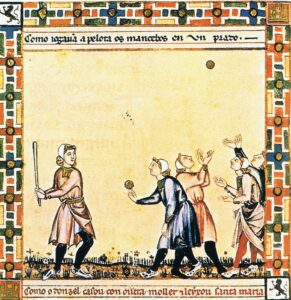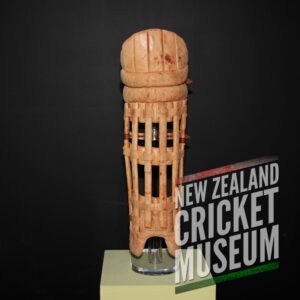Cricket Theory
November 15, 2021
By AHNZ
 The sport of cricket plays a prominent part in New Zealand’s culture as does rugby. Every generation since the Missionaries has been increasingly attracted to the players and the rules and the outcome of contests against other nations. Why? To understand this history we need to go back deeply into human anthropology with an intelligent and comprehensive guide. Until that man comes along here are some inspirations from someone who has read a few Desmond Morris and Douglas Adams books; Me.
The sport of cricket plays a prominent part in New Zealand’s culture as does rugby. Every generation since the Missionaries has been increasingly attracted to the players and the rules and the outcome of contests against other nations. Why? To understand this history we need to go back deeply into human anthropology with an intelligent and comprehensive guide. Until that man comes along here are some inspirations from someone who has read a few Desmond Morris and Douglas Adams books; Me.
Cricket historian Harry Altham identified three categories of club-ball games in his book A History of Cricket (1962)1. The Hockey Group drives a ball back and forth between two targets/goals. The Golf Group drives a ball towards an undefended target. The Cricket Group aims a ball at a defended mark. New Zealand’s games of football/soccer and rugby and netball belong to the Group named after Hockey. Softball, baseball, lapta, and scores of others are variations of a human pattern that finds its highest form in cricket.
Games like these almost span the globe and extend back to our earliest history. We see pictures of proto-cricket in C13th century manuscripts (image, right) and know civilisations in the ancient world played a game belonging to the Cricket Group as early as 1472 BC. The Egyptians may have been 1000 years before that with their game seker-hemat (which roughly translates as “batting the ball.2“)

My observation is that many races of the Earth do not play cricket. Africans south of the Sahara and Pacific Islanders, eg Maoris, have little if any affinity and nor do the races of the tundra such as the Eskimos or Laplanders. My extrapolation is that the Cricket Group is expressed in peoples who once hunted mega-fauna on the grass plains of the last Ice Age. Specifically, the Woolly Mammoth. As such, cricket is a ritualised abstraction of man’s 10,000 year non-associative learning at the race level. Between 15,000 to 4,000 years ago we hunted mammoth professionally so the question shouldn’t be why is there still an echo of that today but why wouldn’t there be?
(I’m really starting to talk myself into this. Has nobody thought of all of this before?)
Parallels Between Cricket and Hunting Mammoth
The Pitch: Often depicted in our media as plodding through the snow, mammoths were really grazers of the green grasslands of the last Ice Age. A cricket pitch resembles and idealises that ancient hunting ground with its green flat plane of short grass. Central to all is the pitch itself, a 20 meter patch where batsman faces the thrower of the ball. Even today the kill distance for throwing a javelin is 20-30 meters. However, with a spear-thrower the 150m diameter of the cricket field itself is a distance that makes sense. The long-range throwing (fielding) keeps the target confined to the center and the short-range throwing, the “bowl”, distributes potential kill shots.
 The Batsman: The two cricket batsmen are all alone and surrounded in the killing grounds by a team of huntsman who try to ritually kill them. Their goal is to defend themselves by fending off the projectile hurled at them. If their vital organ, the Wicket and Bales, is ruptured then they become deceased or “dismissed” as it is called in cricket terminology. Usually the target “facing” the bowler is at risk but it’s also possible to opportunistically ‘kill’ his partner by striking his vitals with the ball if they are undefended. It must have been the same way in a mammoth ambush. The Wicket and Bales resemble large animal bones which are the ones you must break and will win if you play cricket well. Like a mammoth, the batsmen is well padded and swings his ritualised tusk around defensively. The leg pads worn resemble white bones too and early versions at the New Zealand Cricket Museum are even called “skeleton-style batting pads.” Bone armor would certainly be a match for the materials pre-historic man had and used as well as being a ‘lucky charm’ for a successful hunter according to the Law of Simularity.
The Batsman: The two cricket batsmen are all alone and surrounded in the killing grounds by a team of huntsman who try to ritually kill them. Their goal is to defend themselves by fending off the projectile hurled at them. If their vital organ, the Wicket and Bales, is ruptured then they become deceased or “dismissed” as it is called in cricket terminology. Usually the target “facing” the bowler is at risk but it’s also possible to opportunistically ‘kill’ his partner by striking his vitals with the ball if they are undefended. It must have been the same way in a mammoth ambush. The Wicket and Bales resemble large animal bones which are the ones you must break and will win if you play cricket well. Like a mammoth, the batsmen is well padded and swings his ritualised tusk around defensively. The leg pads worn resemble white bones too and early versions at the New Zealand Cricket Museum are even called “skeleton-style batting pads.” Bone armor would certainly be a match for the materials pre-historic man had and used as well as being a ‘lucky charm’ for a successful hunter according to the Law of Simularity.
The Ball: Always blood-red, the cricket ball represents the life’s blood of the target. In pre-history an accurate throw into the tusked and ribbed creature would smash the prey open and end the fight. After 6 “overs” at a time of hurling the ball at the target there is a re-set that is symbolic of running out of spears. The bowler who does not get a kill may be replaced at the end of an over with someone else if the team is losing patience with his inability to achieve results. If the target animal succeeds in batting away the projectile the hunters scramble to get it back to their chief marksman. Or, if the opportunity is there, any hunter can try to ‘kill’ the target from any distance if they can make a precise kill shot on the undefended ribs of its wickets. During this scramble to recover the killer ball the batsman “runs” yet, surrounded, there can be no escape.
Runs: Like the ambushed mammoth the batsman is surrounded without escape. It is rare for a mammoth to win its freedom and if it does it is probably injured. It is also rare for a batsman to “retire” rather than be killed/”out” and if he does he is usually injured and or exhausted too. He can “run” and in doing so score time for his herd/team to escape and this situation is ritualised in cricket by accumulating points arithmetically on the scoreboard. In the ritual the two sides switch places and the hunter becomes the hunted. The attacking team seek to ‘kill’ every batsman by getting them “out.” It was the same for primitive man who hunted their prey to extinction. Indigenous peoples’ “sustainability” bares the same resemblance as short people do to the NBA. It’s not that they wouldn’t love to slam dunk every fish in the sea. It’s that they lack, and lacked, capability to kill every fish in the sea. On the other hand, moa certainly were hunted to extinction and perhaps we became so proficient at ‘mammoth cricket’ that their extinction is on us too.
 Caught Out: When the projectile is batted away by the target (batsman/mammoth) in cricket it is ritualistically imbued with the power to instantly kill the target creature if caught before it hits the earth. If this can be achieved it is met with great joy and equal dismay from the attacking and defending players, respectfully. In a mammoth hunt there’s no great joy to be had in picking up after someone their spear after it has failed to kill and has fallen to the ground. However, if you can grab hold of a spear that is still active because it is embedded in the mammoth and keep hold of it then it is certain the animal is as good as dead. If an attacker loses his grip on such a ‘catch’, or the spear hits the ground, then it’s no catch at all. But if a mammoth has become weakened enough not to be able to throw off a man who is driving a spear into it to kill it then that animal is ready to die and the kill a fait accompli.
Caught Out: When the projectile is batted away by the target (batsman/mammoth) in cricket it is ritualistically imbued with the power to instantly kill the target creature if caught before it hits the earth. If this can be achieved it is met with great joy and equal dismay from the attacking and defending players, respectfully. In a mammoth hunt there’s no great joy to be had in picking up after someone their spear after it has failed to kill and has fallen to the ground. However, if you can grab hold of a spear that is still active because it is embedded in the mammoth and keep hold of it then it is certain the animal is as good as dead. If an attacker loses his grip on such a ‘catch’, or the spear hits the ground, then it’s no catch at all. But if a mammoth has become weakened enough not to be able to throw off a man who is driving a spear into it to kill it then that animal is ready to die and the kill a fait accompli.
Bowler: Like the batsmen there are specialist bowlers whose skill at marksmanship is highly prized by his team and his tribe. Apart from refined ballistic skills through long training of muscle memory the skilled bowler also knows how to read his target animal. He knows how to pick at the defenses of a batsman and wear him down by attrition and to coax him into creating an opening so that a kill shot can be made.
Captains and Coaches: There is a place for past lords of cricket to coach and otherwise bestow their wisdom to the hunters. Elders are kept around as a functional part of the tribe because they can pass on inter-generational knowledge of how best to use equipment and how best to read and respond to the target animal and read the turf. There are libraries full of information and eager young people only too glad to consume it and to talk about old matches. Yet the hunt is a life-risking business for the fit and young so each hunting team also has its captain from among the hunters. He calls the shots, he reads the play, he makes crucial tactical decisions in the field as best he can thanks to the mentoring of the elders.
“Now the players all wear colours, the circus is in town. I can no longer go down there, down to that sacred ground.”- Bradman, Paul Kelly (1987)
When Romana asked Fourth Doctor why humans enjoyed cricket, he told her it was because of race memory from the Krikkit Wars. (PROSE: Doctor Who and the Krikkitmen) Ref. Tardisfandom
“Losers let it happen, winners make it happen.” Ref. 1980s: Hadlee on Pacifism, AHNZ
“Cricket is all attack. It is attack for the bowler, too, whether he is attacking through pace, swing, spin or any or the other arts of deception he employs; it is attack for the fieldsman and, above all, it is attack for the captain.” – p20, Sword of Willow. John Reid (1962)
 Fans: Hunting is man’s work which is why women tend to be less skillful at cricket and their teams command less attention from fans who are also mostly male. A Commentator is a sort of informed fan who enhances the observation of the spectators with informed observations. This is especially so in TV and radio coverage but will have evolved from a scout watching the mammoth ambush and re-telling what he saw from his vantage to those who did not see for themselves. The fans share in the joy of every kill or the resentment and recrimination when a hunt goes badly. New Zealand cricket fans become so caught up and attached to the actions of professional sportsmen that they think that “we” have won or lost when really they had nothing to do with it. For our ancient spectator ancestors though, watching the game/hunt was existentially important. The results decided how much fiber and meat and bone was about to be won or lost. You can see the same rejoicing or disappointment on the fans faces to match the way their ancestors must have felt. While Ice Age man carried away live-giving resources from the carnage of the dismissed we today have fans who bring home various merchandise artifacts cleverly sold to them by New Zealand Cricket Incorporated (1982.)
Fans: Hunting is man’s work which is why women tend to be less skillful at cricket and their teams command less attention from fans who are also mostly male. A Commentator is a sort of informed fan who enhances the observation of the spectators with informed observations. This is especially so in TV and radio coverage but will have evolved from a scout watching the mammoth ambush and re-telling what he saw from his vantage to those who did not see for themselves. The fans share in the joy of every kill or the resentment and recrimination when a hunt goes badly. New Zealand cricket fans become so caught up and attached to the actions of professional sportsmen that they think that “we” have won or lost when really they had nothing to do with it. For our ancient spectator ancestors though, watching the game/hunt was existentially important. The results decided how much fiber and meat and bone was about to be won or lost. You can see the same rejoicing or disappointment on the fans faces to match the way their ancestors must have felt. While Ice Age man carried away live-giving resources from the carnage of the dismissed we today have fans who bring home various merchandise artifacts cleverly sold to them by New Zealand Cricket Incorporated (1982.)
A spectator’s imprinted primordial connection to a corporate firm of cricket players has been co-opted so the fan will pay for merchandise and TV subscriptions and expensive food and drink and entry fees to watch other men pursue greatness. Cricket fans are tribalistic and even manic these days but fandom has changed with the evolution of the sport in New Zealand to match our culture. The Baby Boomers corporitised what Paul Kelly called ‘that sacred ground’ to the point where those connected to what cricket had been before could no longer connect with what had become a “circus.” The Corporations found a way to monetise a natIon’s sense of belonging and sell it back to them for money.
Covers: The green grassy plain that is the hunting ground for the cricket player must sometimes be closed on account of rain. To protect the pitch from getting wet and ruining the ritual the “covers” come out to blanket it until the sky clears and play can resume. In the ancient grasslands play also came to an end when the grasses became covered by ice and snow which signaled that hunting, at least in the form described above, came to a close. No wonder that these covers are snow white as are the traditional white garb of the cricketer whose ancestors emerged camouflaged from the white background to engage their opponents on the green pasture.
—
1 I’ve wanted to read this book for months but unfortunately the only copy is in the locked down city of Auckland where none may enter. If the National Library had it or had it then they’d probably get rid of it for not being related to New Zealand history as per their current policy
2 Ref. 5 Bat-and-ball Games That Predate Baseball; How Stuff Works
Image ref. Modified image from Shutterstock via Live Science (2019)
Image ref. Young men are shown playing a bat-and-ball game in a 13th-century manuscript of the Galician Cantigas de Santa Maria; Ref. Wikipedia
Image ref. Pads: skeleton-style batting pad, NZ Cricket Museum; Digital NZ
Image ref. Kenosha Public Museum; Trip Advisor
Note: Douglas Adams imagined cricket to be an expression of race memory imprinted on the human race due to past conflicts with hostile aliens from planet Krikkit; Ref. Life, the Universe and Everything (1982)
Ref. also Policemen are not Retailers; NZB3
2 thoughts on "Cricket Theory"
Leave a Reply
 Like Comment Share
Like Comment Share






Brilliant. But what of Soccer Darts and Bowls. Soccer / Football especially. Is the field a battlefield and the chanting a battlefield war cry or perhaps the goals are opposing Armies and the ball of no significance until it is in goal/heart of the other side.
Well thanks! Never seen anyone connect dots like that before. Yes I think soccer is recruited from clashing armies of the sort that soccer nations have known for thousands of years.